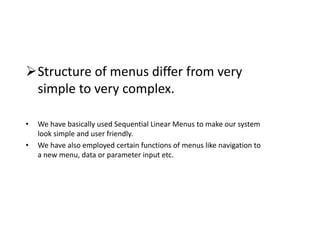HCI Project: Master Mind
- 1. Online Quiz Aarthi Bhandary 01 Gauri Pulekar 16
- 2. User-friendly âĒ Understanding the needs of user is very essential for designing a system. âĒ Users are most important part of the systems. âĒ Advantages â Easy to understand â Can be used by anyone â No additional knowledge required. â Only basic knowledge of English.
- 3. HCI âĒ Humanâcomputer Interaction involves the study, planning, and design of the interaction between users and computers.
- 6. EXPERIMENT 2 To study and implement effectiveness of screen design
- 7. ï Interface Design goals âĒ The aim is to reduce visual, intellectual, memory, and motor work. âĒ No difficulty in locating any piece of information with the help of catchy icons and simple expressions. ï Organizing elements clearly and meaningfully âĒ Clear and clean organization of display elements makes it easier to recognize the screenâs essential elements. âĒ Avoidance of clustering and random placement of icons.
- 8. ï Consistency âĒ Users will commit fewer errors when the visual aspects of information sites are consistent. âĒ Increase in user satisfaction and reduction in learning time. ï Navigation and Flow âĒ Navigation should be obvious and easy. âĒ The direction of movement should be consistent and rhythmic.
- 9. INEFFECTIVE
- 10. EFFECTIVE
- 11. EXPERIMENT 3 To study and implement direct and indirect manipulation strategies of GUI design.
- 12. ï Direct Manipulation âĒ Options and actions are continuously visible. âĒ Actions are rapid and incremental with visible display of results. ï Indirect Manipulation âĒ Sometimes when it is difficult to conceptualize all screen objects in the graphical system due to authentication parameters. âĒ It may be difficult for people to learn and remember all the necessary operations and actions.
- 13. INDIRECT METHOD
- 14. DIRECT METHOD
- 15. EXPERIMENT 4 To study and implement the importance of Human Consideration in GUI Design
- 16. ïOrganizing screen elements. âĒ Some of the parameters to be considered are balance(alignment), regularity, predictability, sequentiality, simplicity, groupings etc. ïChoosing colors. âĒ Color adds dimension and realism to screen usability. âĒ It attracts peopleâs attention.
- 18. EXPERIMENT 5 To study and implement Effectiveness of different types of Menus in screen design
- 19. ïStructure of menus differ from very simple to very complex. âĒ We have basically used Sequential Linear Menus to make our system look simple and user friendly. âĒ We have also employed certain functions of menus like navigation to a new menu, data or parameter input etc.
- 20. EXPERIMENT 6 To study and implement selecting appropriate windows for a system
- 22. EXPERIMENT 7 To study and implement screen navigation and flow
- 23. ïNavigation and flow. âĒ Navigation should be easy to accomplish. âĒ It should be a little logical and predictive. ïVisually pleasing composition. ïBalance âĒ An equilibrium or stability is required within the design elements. ïSymmetry. ïLegibility and Readability.
- 27. Thank You !



























